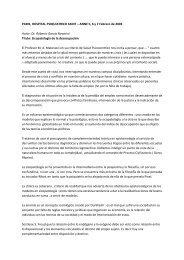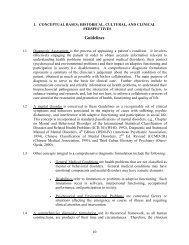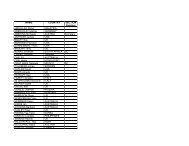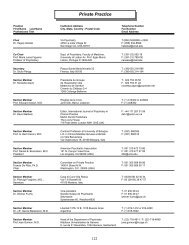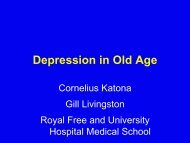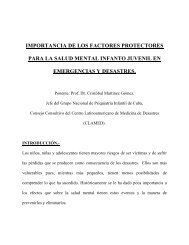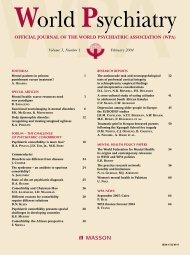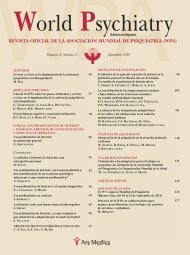ABSTRACTS - World Psychiatric Association
ABSTRACTS - World Psychiatric Association
ABSTRACTS - World Psychiatric Association
Create successful ePaper yourself
Turn your PDF publications into a flip-book with our unique Google optimized e-Paper software.
as a structural imbalance between hospital-based and outpatient care.<br />
Available resources are decreasing as the demand is rising (+74% of<br />
adult patients treated in the public sector over the last 15 years). The<br />
creation of facilities and teams not well integrated in the mental<br />
health care system, and the enduring gaps between health care, social<br />
care, the educational and juridical systems, are often translated in<br />
poor coordination and difficult integration between different roles<br />
and functions. Based on this critical evaluation of mental health care<br />
in France, in 2005 the government has set up a psychiatric and mental<br />
health care plan covering the period 2005-2008. This aims at<br />
improving the coordination and integration between different sectors<br />
of health and social care; to promote the involvement of patients,<br />
families and professionals in decision-making and to launch antistigma<br />
programmes; to improve the quality of care and research activities;<br />
and to tackle specific disorders or problems presented by specific<br />
population groups through the implementation of targeted programmes.<br />
However, criticisms about the real functioning of this plan<br />
have been expressed by different stakeholders.<br />
RS13.3.<br />
DEVELOPMENTS IN ENGLISH MENTAL HEALTH<br />
CARE: 1988 TO 2008<br />
G. Glover<br />
University of Durham, UK<br />
Mental health care services in England have developed considerably<br />
in the last 20 years. During the late 1980s and early 1990s, the priority<br />
was to develop adequate coordination for the non-institutional<br />
care approaches for people with severe mental illnesses, which were,<br />
by then, becoming the normal approach. Following a major government<br />
review in 1998, the focus has been on developing uniform<br />
access to home-based care teams for acute mental health crises, early<br />
intervention services for psychosis and assertive outreach teams for<br />
people with chronic illness at risk of frequent relapse. Since 2000, a<br />
number of detailed data sources have been set up documenting their<br />
structure and activity. An annual service mapping exercise has been<br />
carried out, covering services for mentally ill adults of working-age<br />
each year since 2000, and children and adolescents since 2002. A<br />
dataset documenting the content and timing of mental health care for<br />
working-age and older adults has been in place since April 2003. This<br />
paper outlines the principles underlying the developments, attempts<br />
to quantify the extent of the changes overall, and touches briefly on<br />
the issue of how consistent the changes have been in different parts of<br />
England.<br />
RS13.4.<br />
MENTAL HEALTH CARE IN GERMANY: CURRENT<br />
STATE AND TRENDS<br />
H.J. Salize, W. Rössler, T. Becker<br />
Central Institute of Mental Health, Mannheim, Germany;<br />
<strong>Psychiatric</strong> University Hospital, Zurich, Switzerland; <strong>Psychiatric</strong><br />
University Hospital, Ulm, Germany<br />
Germany turned towards community-based mental health care in the<br />
mid seventies, within a general climate of social and political reform.<br />
The continuing deinstitutionalisation process and the implementation<br />
of community mental health services was considerably affected<br />
by the reunification of East and West Germany in 1990, which<br />
required dramatic changes in the structure and quality of the mental<br />
health care system of the former German Democratic Republic. Overall,<br />
German mental health care is organised as a subsidiary system,<br />
where planning and regulating mental health care is the responsibility<br />
of the 16 federal states. So, German mental health care provision is<br />
spread among many sectors and characterised by considerable<br />
regional differences. A key characteristic is the particularly wide gap<br />
between inpatient and outpatient services, which are funded separately<br />
and staffed by different teams. However, the momentum of the<br />
psychiatric reform has been strong enough to assimilate the completely<br />
different mental health care system of the former German<br />
Democratic Republic and, in the course of a decade, to re-structure<br />
mental health services for an additional 17-18 million new inhabitants.<br />
In an ongoing struggle to adapt to changing administrative setups,<br />
legal frameworks, and financial constraints, psychiatry in Germany<br />
is currently facing specific problems and is seriously challenged<br />
to defend the considerable achievements of the past. A major obstacle<br />
to achieving this aim lies in the fragmented system of mental<br />
health care provision and mental health care funding.<br />
RS14.<br />
OBSESSIVE-COMPULSIVE DISORDERS:<br />
TRANSLATIONAL APPROACHES<br />
AND NEW THERAPEUTIC STRATEGIES<br />
RS14.1.<br />
BEHAVIORAL ADDICTION, IMPULSIVITY<br />
AND OBSESSIVE-COMPULSIVE DISORDER<br />
S. Pallanti, S. Bernardi<br />
Department of Psychiatry, University of Florence, Italy;<br />
Department of Psychiatry, Mount Sinai School of Medicine, New<br />
York, NY, USA<br />
As part of the research planning agenda for the DSM-V concerning<br />
obsessive-compulsive-related disorders, experts from academic medical<br />
centers around the world suggest the creation of a new diagnostic<br />
category that includes behavioral and substance addictions.<br />
Chemical and behavioral addictions, characterized by impulsive<br />
choice, reward sensitivity, and involvement of fronto-striatal brain<br />
circuitry, with frontal lobe deficits, are conceptualized are as parallel<br />
category to obsessive-compulsive disorder (OCD) spectrum. Craving<br />
and impulsivity, in fact, are complex phenomena that involve different<br />
brain circuitries and neurobiological factors. Both are present in<br />
different psychiatric disorders, with different clinical presentations<br />
and phenomenologies. One of those forms would be an obsessivelike<br />
craving, where craving is experienced as an intrusive thought<br />
resulting in impaired control. This obsessive-compulsive subtype of<br />
craving might be correlated, similarly to OCD, to serotonin dysfunction.<br />
According to this model, the most fully documented neurobiological<br />
findings regarding impulse control disorder involve serotonin.<br />
Evidence for the involvement of serotonin in pathological gambling<br />
comes from challenge study results, such as an increased prolactin<br />
response to the serotonergic agonists m-CPP and sumatriptan. Challenge<br />
studies analysing growth hormone response to clonidine pointed<br />
out also a different noradrenergic role in pathological gambling.<br />
An involvement of the prefrontal cortex and an action of lithium on<br />
this brain area is hypothesized on the basis of functional neuroimaging<br />
data.<br />
43




